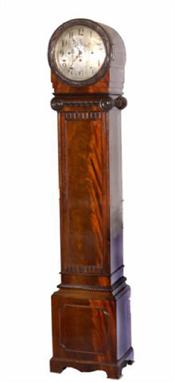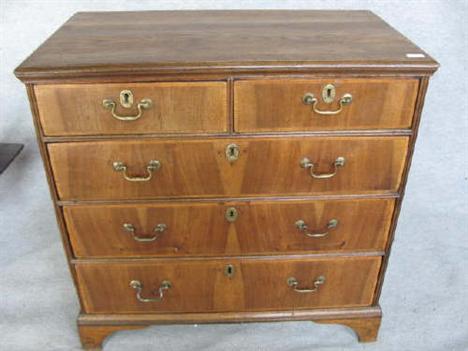A French ebony and brass Religieuse style bracket clock Unsigned, late 19th century, probably incorporating earlier components The eight-day two-train movement rack striking the hours on a bell mounted within the caddy above, with 10.5 x 6 inch blue velvet covered dial applied with brass Roman numeral chapter ring with every minute numbered above foliate festoon swag and scroll cast mount, the caddy-top case with flambeau finials and gilt balustrade frets above Corinthian pilasters to the brass line inlaid front and conforming arch glazed sides, on moulded base with lambrequin panel to apron and on brass ball feet, some damage and losses to case, 53cm high overall.
177692 Preisdatenbank Los(e) gefunden, die Ihrer Suche entsprechen
177692 Lose gefunden, die zu Ihrer Suche passen. Abonnieren Sie die Preisdatenbank, um sofortigen Zugriff auf alle Dienstleistungen der Preisdatenbank zu haben.
Preisdatenbank abonnieren- Liste
- Galerie
-
177692 Los(e)/Seite
A Regency brass-mounted mahogany bracket clock with wall bracket Dawson & Peene, London, circa 1825 The five-pillar twin fusee bell-striking movement with anchor escapement and signed Dawson & Peene, London to backplate, the 7.5 inch circular cream painted Roman numeral convex dial indistinctly inscribed HALES & McCULLOCH, CHEAPSIDE, LONDON, the single pad top break-arch case with brass carrying handle above rectangular side windows and fishscale frets beneath dial, on moulded base with ogee bracket feet, 36cm high excluding handle; with a later(?) mahogany wall bracket, 57cm high overall. Both the partnerships Dawson & Peene and Hales & McCulloch appear to be unrecorded, the latter were probably the original retailers of the clock.
A William IV mahogany bracket clock with original wall bracket Richard Widenham, London, circa 1830. The five -pillar twin fusee bell-striking movement with keyhole shaped plates, anchor escapement and signed Widenham, London to backplate, the 8 inch circular engraved brass Roman numeral dial (formerly silvered) signed Widenham, 13 Lombard St., London to centre and with Strike/Silent switch at 12 o’clock, the drum-head case with scroll moulding to apron above recessed panel to the plinth base with moulded skirt, the wall bracket with scroll support, the clock 45cm high, 63cm high including the bracket. Richard Widenham was a respected chronometer maker, winning an award at the chronometer trials held at the Royal Observatory in 1825. He was known to be working from his Lombard Street address by 1835 and began trading as Widenham and Adams in 1840.
A Regency brass inlaid ebony bracket clock French, London, early 19th century The five-pillar twin fusee rack and bell striking movement with anchor escapement and foliate trail border engraved shaped backplate signed French, Royal Exchange, London, with 8 inch circular cream painted Roman numeral dial in a case with brass ball finials to the domed stepped pediment and brass festoon decoration above dial, the apron with shaped geometric inlaid panel, the sides with brass lion mask ring side handles above brass Gothic arch pierced frets, on stepped base with engine-turned brass feet, 66cm high; with a contemporary brass inlaid wall bracket with line edged platform and stylised foliate scroll inlaid shaped strut, 97cm high overall. Santiago James Moore French is recorded in Baillie, G.H. Watchmakers & Clockmakers of the World as working from Royal Exchange, London, circa 1810- 40.
A William & Mary ebony veneered bracket clock James Mitchell, London, circa 1695 and later The five (formerly six) finned pillar twin fusee movement with backplate engraved with a dolphin amongst flowering foliage and herringbone border, now with later anchor escapement and chiming the quarters on four bells, and with internal rack for the hour strike on a further bell, the 8 inch x 7 inch rectangular brass dial with foliate engraved calendar aperture, ringed winding holes and false bob . Aperture to the matted centre within an applied silvered Roman numeral chapter ring with cruciform half hour markers and Arabic five minutes, the angles with winged cherub head spandrels beneath signature James Mitchell, London within engraved foliate scrolls to upper edge of dial, the ebony veneered case with gilt foliate cast handle to the caddy top above horizontal sound frets and rectangular windows to sides, on moulded base, movement with alterations, case with restorations, 38cm high excluding handle.
A George III mahogany eight-day longcase clock Indistinctly signed, early 19th century The five-pillar rack and bell striking movement with 12 inch plain white painted Roman numeral break-arch dial with subsidiary seconds and calendar dials to centre and STRIKE/SILENT dial to arch, the case with shaped crest to the break-arch cornice and brass stop-fluted reeded pilasters to hood above break-arch trunk door flanked by conforming fluted canted angles, on shaped panel outlined plinth base with moulded skirt incorporating shaped apron and bracket feet, dial with repairs, signature rubbed, 221cm high.
An inlaid mahogany eight-day quarter chiming longcase clock Unsigned, 19th century The substantial four-pillar triple train movement chiming the quarters on eight graduated bells and striking the hour on a gong, the 13 inch brass break-arch dial with subsidiary seconds dial to the matted centre within an applied silvered Roman numeral chapter ring with fleur de lys half hour markers and Arabic five minutes, the angles with female mask and scroll cast spandrels and with EIGHT BELLS/WESTMINSTER Chime selection switch at 3 o’clock, the arch with CHIME/SILENT dial flanked by dolphin cast mounts, now in a case with swan neck pediment and Corinthian pilasters to hood above narrow swag and foliate scroll inlaid trunk door flanked by conforming pilasters, on raised panel fronted plinth base with bracket feet, case mid 19th century, marquetry decoration, movement and dial late 19th century.
A fine George III mahogany eight-day longcase clock John Grant, London, circa 1790. The five-pillar rack and bell striking movement with knurled calibrated rating nut and large lenticular bob to the steel rod pendulum supported from the substantial back-cock, the 12 inch single-sheet silvered brass Roman numeral break-arch dial with subsidiary seconds and calendar dials and signed GRANT Fleet Street, LONDON No. 365 to centre, with Arabic five minutes and plain spandrels beneath arch with STRIKE/SILENT dial, the break-arch case with brass stop-fluted pilasters to hood above break-arch trunk door flanked by conforming brass-mounted fluted quarter columns to angles, on raised shaped panel fronted plinth base with double skirt incorporating shaped apron and bracket feet, 222cm high. John Grant is recorded as working in Fleet Street 1786-1810. He was apprenticed to and later went into partnership with his uncle the renowned clock and chronometer maker Alexander Cumming who, along with other eminent makers such as Thomas Mudge, was appointed by the board of longitude to assess Harrison’s marine timekeepers.
A William IV mahogany eight-day longcase clock with moonphase Frances Pugh, Warrington, circa 1830. The four-pillar rack and bell striking movement with 14 inch white painted Roman numeral break-arch dial with subsidiary seconds and calendar dials and signed Frances Pugh, Warrington to centre, the spandrels painted with Classical maidens emblematic of the four seasons beneath rolling moonphase to arch, the swan neck pedimented case with gilt foliate painted infill decoration above dial and reeded pilasters to hood, the trunk with book-match veneered shaped-top door flanked by conforming pilasters, on panel inlaid plinth base with ogee bracket feet, 226cm high.
An Edwardian inlaid mahogany quarter chiming longcase clock Unsigned, early 20th century The substantial four -pillar triple train movement chiming the quarters on eight bells and striking the hour on a gong, the 12.5 inch brass break-arch dial with subsidiary seconds dial to the polished centre within an applied silvered Roman numeral chapter ring with Arabic five minutes and stylised fleur de lys half hour markers, the angles with cherub head and scroll cast spandrels beneath STRIKE/SILENT dial flanked by conforming mounts to arch, the case with swan neck pediment above military trophy infill and brass reeded columns to hood, the trunk with central oval panel of a Grecian warrior within symmetrical foliate scroll and swag borders to the shallow arch trunk door, the crossbanded plinth base centred with conforming panel of a chariot drawn by two horses, on moulded skirt incorporating shaped apron and bracket feet, 236cm high.
A George III figured mahogany eight-day longcase clock Charles Penton, London, circa 1775 The five-pillar rack and bell striking movement with 12 inch brass break-arch dial with recessed subsidiary seconds dial, calendar aperture and shaped plaque signed Cha’s Penton, London to the matted centre, within an applied Roman numeral chapter ring with Arabic five minutes and foliate cast spandrels to angles beneath Strike/Silent dial flanked by conforming mounts to arch, in a break-arch case with brass stop-fluted pilasters to hood above break- arch door flanked by conforming stop-fluted quarter columns to trunk, on shaped raised panel plinth base with double moulded skirt incorporating bracket feet with shaped apron between, 222cm high. Charles Penton is recorded in Baillie, G.H. Watchmakers & Clockmakers of the World as working in London 1774-8.
Victorian break front Credenza, with mahogany veneered top above a walnut frieze, inlaid and decorated with flowers and scrolls, above an arched glazed door, flanked by small arched glazed doors, separated by gilt metal mounted and inlaid pilasters, with shaped apron, bracket feet, 178cms, (5'10").
George III mahogany Secretaire Bookcase, the upper half with moulded cornice, the interior fitted with three shelves enclosed by astragal glazed doors, the lower half with a rectangular top with moulded edge, the interior fitted with drawers, pigeonholes and central cupboard, enclosed by a fall front, with two short and two long drawers below, all with brass swan-neck handles and on bracket feet, 117cms, (3'10").
A presentation casket by J Forrest (probably), Glasgow 1928 - 29, retailed by Whytock & Sons Dundee, of rectangular outline with flared base, having borders of alternating panels of Celtic knot and interlace separated by plain bosses, the panels decorated with scenes of official buildings and coats of arms, on four bracket feet, the hinged domed lid with four Celtic bosses in corners and panelled domed section with presentation inscription and Dundee coat of ams as finial, in fitted case 30cm x 18cm x 15cm Notes: the presentation inscription reads 'Presented by, The City of Dundee, to, The Right Honourable Sir John Gilmour Bart, D.S.O L.L.D, , Secretary of State for Scotland, with its freedom, 10th October 1928'
A REGENCY MAHOGANY SECRETAIRE BOOKCASE with a moulded cornice above two glazed doors with lancet astragals enclosing adjustable shelving, the secretaire drawer enclosing an arrangement of pigeon holes, short and long drawers, three graduated long drawers below on bracket feet with replaced turned wood knob handles, 48" wide
A WALNUT CASED MINIATURE OR 'GRANDMOTHER' LONGCASE CLOCK, the movement with verge escapement and 5" square brass dial, silvered chapter ring, Roman numerals and alarm subsidiary dial, cherub head spandrels to each corner, signed John May, London, the case with blind fret work decoration, turned brass finials, embossed side panels and boxwood line inlay on bracket feet, 58" high.
A VICTORIAN MAHOGANY LONGCASE CLOCK having a circular steel dial signed Maple London, with engraved ribbon swag decoration and Westminster Whittington chime enclosed by a convex glazed door with carved acanthus surround, the case with scroll and gadrooned decoration, moulded panel base and bracket feet, with three brass weights and pendulum, 6 ft 8" high overall, dial 12 1/2" diameter.
-
177692 Los(e)/Seite













































